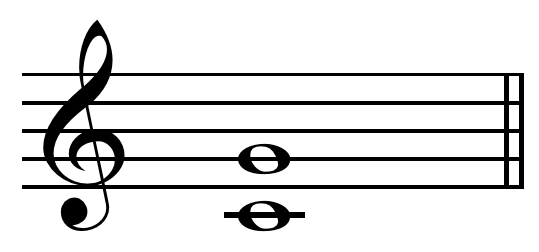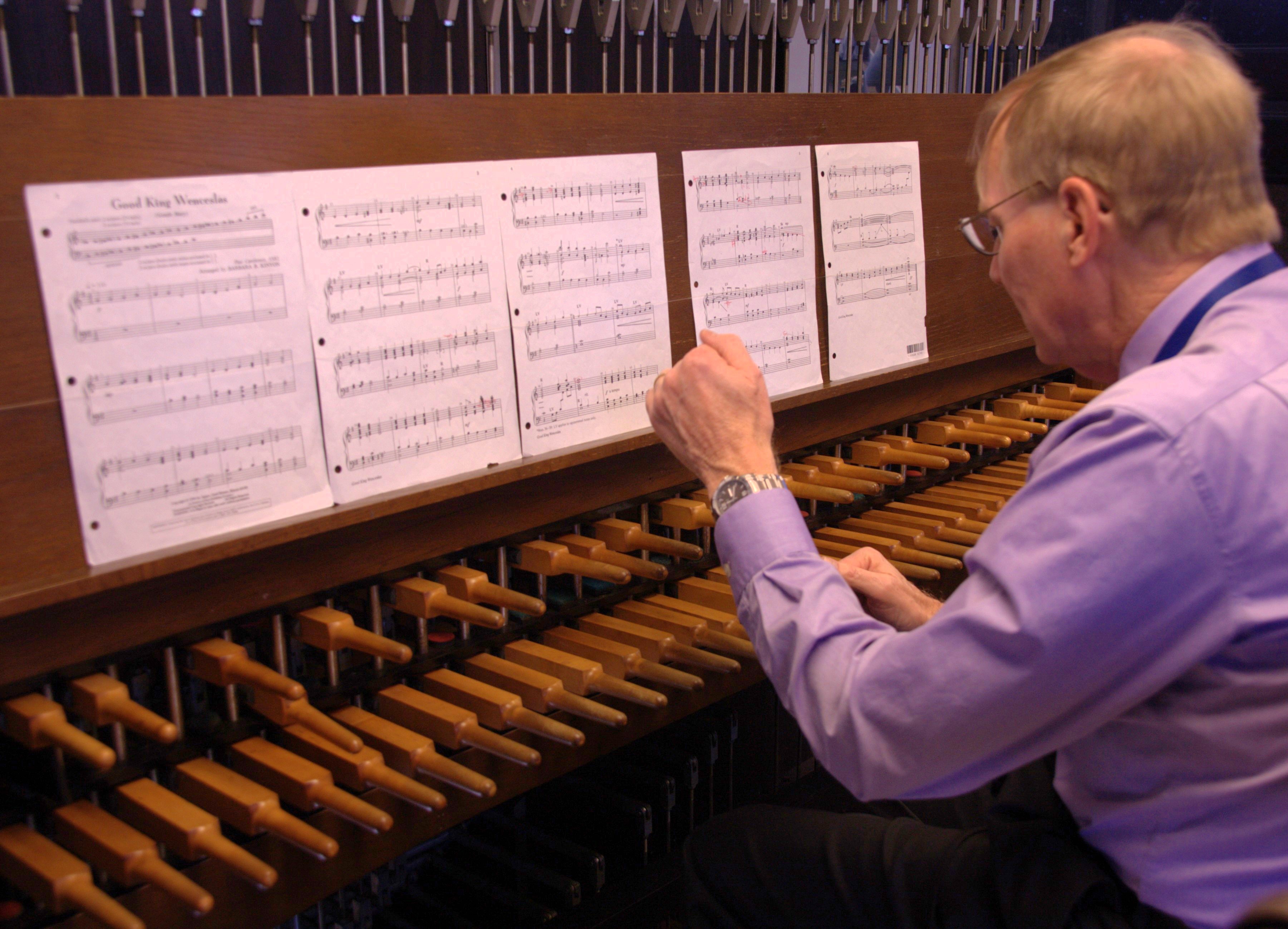|
Strike Tone
The strike tone, strike note, or tap note, of a percussion instrument (e.g. bell, chime or gong) when struck, is the dominant note perceived immediately by the human ear. It is also known as the prime or fundamental note. However, an analysis of the bell's frequency spectrum reveals that the fundamental only exists weakly and its dominance is a human perception of a note built up by the complex series of harmonics that are generated. The correct and accurate harmonic tuning is therefore important in creating a good strike tone. Composition of the strike tone When a bell is struck, the energy imparted causes vibration of the bell in a complex manner and a series of tones known as partials or harmonics are generated. "This atonal strike sound includes many inharmonic partials that die out quickly, giving way to a strike note or strike tone that is dominated by the prominent partials of the bell. Most observers identify the metallic strike note as having a pitch at or near the ... [...More Info...] [...Related Items...] OR: [Wikipedia] [Google] [Baidu] |
Percussion Instrument
A percussion instrument is a musical instrument that is sounded by being struck or scraped by a percussion mallet, beater including attached or enclosed beaters or Rattle (percussion beater), rattles struck, scraped or rubbed by hand or struck against another similar instrument. Excluding Zoomusicology, zoomusicological instruments and the human voice, the percussion family is believed to include the oldest musical instruments.''The Oxford Companion to Music'', 10th edition, p.775, In spite of being a very common term to designate instruments, and to relate them to their players, the percussionists, percussion is not a systematic classificatory category of instruments, as described by the scientific field of organology. It is shown below that percussion instruments may belong to the organological classes of idiophone, membranophone, aerophone and String instrument, chordophone. The percussion section of an orchestra most commonly contains instruments such as the timpani, ... [...More Info...] [...Related Items...] OR: [Wikipedia] [Google] [Baidu] |
Perfect Fifth
In music theory, a perfect fifth is the Interval (music), musical interval corresponding to a pair of pitch (music), pitches with a frequency ratio of 3:2, or very nearly so. In classical music from Western culture, a fifth is the interval from the first to the last of the first five consecutive Musical note, notes in a diatonic scale. The perfect fifth (often abbreviated P5) spans seven semitones, while the Tritone, diminished fifth spans six and the augmented fifth spans eight semitones. For example, the interval from C to G is a perfect fifth, as the note G lies seven semitones above C. The perfect fifth may be derived from the Harmonic series (music), harmonic series as the interval between the second and third harmonics. In a diatonic scale, the dominant (music), dominant note is a perfect fifth above the tonic (music), tonic note. The perfect fifth is more consonance and dissonance, consonant, or stable, than any other interval except the unison and the octave. It occu ... [...More Info...] [...Related Items...] OR: [Wikipedia] [Google] [Baidu] |
Acoustics
Acoustics is a branch of physics that deals with the study of mechanical waves in gases, liquids, and solids including topics such as vibration, sound, ultrasound and infrasound. A scientist who works in the field of acoustics is an acoustician while someone working in the field of acoustics technology may be called an Acoustical engineering, acoustical engineer. The application of acoustics is present in almost all aspects of modern society with the most obvious being the audio and noise control industries. Hearing (sense), Hearing is one of the most crucial means of survival in the animal world and speech is one of the most distinctive characteristics of human development and culture. Accordingly, the science of acoustics spreads across many facets of human society—music, medicine, architecture, industrial production, warfare and more. Likewise, animal species such as songbirds and frogs use sound and hearing as a key element of mating rituals or for marking territories. Art, ... [...More Info...] [...Related Items...] OR: [Wikipedia] [Google] [Baidu] |
Jonathan Harvey - Winchester Cathedral Bell Spectrum
Jonathan may refer to: *Jonathan (name), a masculine given name Media * ''Jonathan'' (1970 film), a German film directed by Hans W. Geißendörfer * ''Jonathan'' (2016 film), a German film directed by Piotr J. Lewandowski * ''Jonathan'' (2018 film), an American film directed by Bill Oliver * ''Jonathan'' (Buffy comic), a 2001 comic book based on the ''Buffy the Vampire Slayer'' television series *Jonathan (TV show), a Welsh-language television show hosted by ex-rugby player Jonathan Davies People and biblical figures Bible *Jonathan (1 Samuel), son of King Saul of Israel and friend of David, in the Books of Samuel *Jonathan (Judges), in the Book of Judges *Jonathan (son of Abiathar), in 2 Samuel and 1 Kings Judaism *Jonathan Apphus, fifth son of Mattathias and leader of the Hasmonean dynasty of Judea from 161 to 143 BCE * Rabbi Jonathan, 2nd century *Jonathan (High Priest), a High Priest of Israel in the 1st century Footballers * Jonathan (footballer, born 1991) * Jonathan ... [...More Info...] [...Related Items...] OR: [Wikipedia] [Google] [Baidu] |
Major Sixth
In music theory, a sixth is a musical interval encompassing six note letter names or staff positions (see Interval number for more details), and the major sixth is one of two commonly occurring sixths. It is qualified as ''major'' because it is the larger of the two. The major sixth spans nine semitones. Its smaller counterpart, the minor sixth, spans eight semitones. For example, the interval from C up to the nearest A is a major sixth. It is a sixth because it encompasses six note letter names (C, D, E, F, G, A) and six staff positions. It is a major sixth, not a minor sixth, because the note A lies nine semitones above C. Diminished and augmented sixths (such as C to A and C to A) span the same number of note letter names and staff positions, but consist of a different number of semitones (seven and ten, respectively). A commonly cited example of a melody featuring the major sixth as its opening is " My Bonnie Lies Over the Ocean".Blake Neely, ''Piano For Dummies'', se ... [...More Info...] [...Related Items...] OR: [Wikipedia] [Google] [Baidu] |
Perfect Fourth
A fourth is a interval (music), musical interval encompassing four staff positions in the music notation of Western culture, and a perfect fourth () is the fourth spanning five semitones (half steps, or half tones). For example, the ascending interval from C to the next F is a perfect fourth, because the note F is the fifth semitone above C, and there are four staff positions between C and F. Diminished fourth, Diminished and Tritone, augmented fourths span the same number of staff positions, but consist of a different number of semitones (four and six, respectively). The perfect fourth may be derived from the Harmonic series (music), harmonic series as the interval between the third and fourth harmonics. The term ''perfect'' identifies this interval as belonging to the group of perfect intervals, so called because they are neither major nor minor. A perfect fourth in just intonation corresponds to a pitch ratio of 4:3, or about 498 cent (music), cents (), while in equal temperam ... [...More Info...] [...Related Items...] OR: [Wikipedia] [Google] [Baidu] |
Major Third
In music theory, a third is a Interval (music), musical interval encompassing three staff positions (see Interval (music)#Number, Interval number for more details), and the major third () is a third spanning four Semitone, half steps or two Whole step, whole steps. Along with the minor third, the major third is one of two commonly occurring thirds. It is described as ''major'' because it is the larger interval of the two: The major third spans four semitones, whereas the minor third only spans three. For example, the interval from C to E is a major third, as the note E lies four semitones above C, and there are three staff positions from C to E. Diminished third, Diminished and augmented thirds are shown on the musical staff the same number of lines and spaces apart, but contain a different number of semitones in pitch (two and five). Harmonic and non-harmonic thirds The major third may be derived from the harmonic series (music), harmonic series as the interval be ... [...More Info...] [...Related Items...] OR: [Wikipedia] [Google] [Baidu] |
Unison
Unison (stylised as UNISON) is a Great Britain, British trade union. Along with Unite the Union, Unite, Unison is one of the two largest trade unions in the United Kingdom, with over 1.2 million members who work predominantly in public services, including local government, education, health and outsourcing, outsourced services. The union was formed in 1993 when three public sector trade unions, the National Association of Local Government Officers, National and Local Government Officers Association (NALGO), the National Union of Public Employees (NUPE) and the Confederation of Health Service Employees (COHSE) merged. UNISON's current general secretary is Christina McAnea, who replaced Dave Prentis in 2021. Members and organisation Members of UNISON are typically from industries within the public sector and generally cover both full-time and part-time support and administrative staff. The majority of people joining UNISON are workers within sectors such as local government, e ... [...More Info...] [...Related Items...] OR: [Wikipedia] [Google] [Baidu] |
Carillon
A carillon ( , ) is a pitched percussion instrument that is played with a musical keyboard, keyboard and consists of at least 23 bells. The bells are Bellfounding, cast in Bell metal, bronze, hung in fixed suspension, and Musical tuning, tuned in Chromatic scale, chromatic order so that they can be sounded harmoniously together. They are struck with clappers connected to a keyboard of wooden batons played with the hands and Pedal keyboard, pedals played with the feet. Often housed in bell towers, carillons are usually owned by churches, universities, or municipalities. They can include an automatic system through which the time is announced and simple tunes are played throughout the day. Carillons come in many designs, weights, sizes, and sounds. They are among the world's heaviest instruments, and the heaviest carillon weighs over . Most weigh between . To be considered a carillon, a minimum of 23 bells are needed; otherwise, it is called a chime (bell instrument), chime. S ... [...More Info...] [...Related Items...] OR: [Wikipedia] [Google] [Baidu] |
Church Bell
A church bell is a bell in a church building designed to be heard outside the building. It can be a single bell, or part of a set of bells. Their main function is to call worshippers to the church for a service of worship, but are also rung on special occasions such as a wedding, or a funeral service. In certain Christian traditions, such as Catholicism and Lutheranism, church bells signify to people both inside and outside of the church that a particular part of the service (such as the recitation of the Lord's Prayer or consecration of Holy Communion) has been reached. The ringing of church bells thrice a day occurs in congregations of certain Christian denominations as a call to prayer, reminding the faithful to pray the Lord's Prayer or the Angelus Domini. The traditional European church bell ''(see cutaway drawing)'' used in Christian churches worldwide consists of a cup-shaped metal resonator with a pivoted clapper hanging inside which strikes the sides when the bell ... [...More Info...] [...Related Items...] OR: [Wikipedia] [Google] [Baidu] |
Combination Tone
A combination tone (also called resultant tone or subjective tone)Combination Tone , ''Britannica.com''. Accessed September 2015. is a psychoacoustic phenomenon of an additional tone or tones that are artificially perceived when two real tones are sounded at the same time. Their discovery is credited to the violinist Giuseppe Tartini, so they are also called Tartini tones. There are two types of combination tones: sum tones whose are found by adding the frequencies of the ... [...More Info...] [...Related Items...] OR: [Wikipedia] [Google] [Baidu] |
Harmonic Series (music)
The harmonic series (also overtone series) is the sequence of harmonics, musical tones, or pure tones whose frequency is an integer multiple of a ''fundamental frequency''. Definite pitch, Pitched musical instruments are often based on an Acoustics, acoustic resonator such as a String (music), string or a column of air, which Oscillation, oscillates at numerous Normal mode, modes simultaneously. As waves travel in both directions along the string or air column, they reinforce and cancel one another to form standing waves. Interaction with the surrounding air produces audible sound waves, which travel away from the instrument. These frequencies are generally integer multiples, or harmonics, of the Fundamental frequency, fundamental and such multiples form the Harmonic series (mathematics), harmonic series. The fundamental, which is usually perceived as the lowest #Partial, partial present, is generally perceived as the Pitch (music), pitch of a musical tone. The musical timbre of ... [...More Info...] [...Related Items...] OR: [Wikipedia] [Google] [Baidu] |






